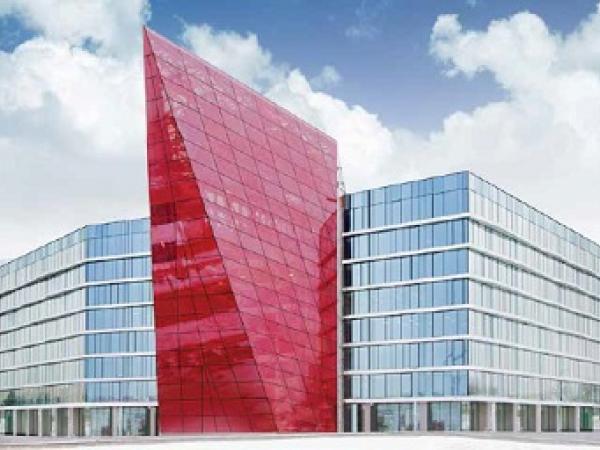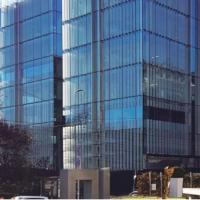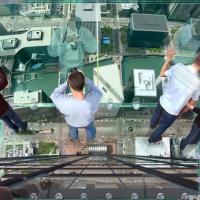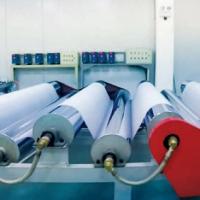The laminated glass panels incorporates SEFAR® Architecture VISION 260/55 with 55% open fabric mesh for the colour and texture effects and a DuPont™ SentryGlas® interlayer for structural strength.
Designed to symbolise a crystal of sylvinite – a crucial ore used for the production of Potash – the new HQ for the Belarusian Potash Company (BPC) is a staggering example of glazing being deployed to maximise light and colour. A combination of coloured fabric from Sefar and DuPont™ SentryGlas® have created and aesthetically pleasing and structurally robust glazing design that really stands out.
Designed by Varabyeu Partners architects, the building comprises offices, meeting rooms, a 180-seat conference hall, a reception area and guest apartments. Employee facilities also include a 56-seat café an underground car park and a gym.
The building is formed from two wings joined at the centre the stylised red crystal, the idea being that the building looks like a bird when viewed from above. The wings are connected by a full-height atrium that joins the crystal entrance hall with a system of staircases and panoramic elevators. Each wing represents a gallery to create an air of comfort and calm.
The red crystal structure at the centre deploys SEFAR® Architecture VISION 260/55 with 55% open space, which gives glass a textile-like structural quality. It is decorated with a reflective red aluminium metal coating on its exterior-facing side, reflecting the constantly changing climatic conditions around the building.
While from the inside, the black fabric permits an almost uninhibited view of the outside world. The laminated glass panels deploy a SentryGlas® interlayer, which adds to the structural strength of the design, without additional weight or design compromises. In total the glass façade covers 2,850m2 and is applied on a steel skeleton covered by a stick frame construction structural system.
.jpg)
According to the owner, D.Sc. Dmitri Sobolevski from GLASSBEL: "SentryGlas® is the material of future construction with certain unique structural performance. GLASSBEL through numerous tests and trials has achieved proper ways of working with SentryGlas and on a results, unique projects such as Belarusian Potash Company's office has been done. However GLASSBEL is finding further ways of using SenryGlas and maximizing its performance".
According to Jérôme Lugrin from Sefar: "SentryGlas® and Sefar Architecture VISION Fabric work very well together to produce a strong yet aesthetically pleasing design. Its ability to maintain its transparency and optical properties in the long term also means that the aesthetically appealing nature of the design is visible for many years. SentryGlas® outperformed PVB in terms of cohesion with the fabric mesh ensuring greater moisture resistance and temperature stability for longer term durability."
.jpg)
Lighter façade panels enable more subtle supporting structures
For decades, interlayers made of polyvinyl butyral (PVB) have been the industry standard when producing laminated safety glass. Architects are well aware of the possibilities and limitations of such glass when used extensively in façade engineering, for roofing and window panels. In contrast, SentryGlas® enables an entirely new approach because the interlayer is over 100 times stiffer and five times stronger than PVB.
As a consequence, there is an almost perfect transmission of load between two laminated sheets of glass, even at high temperatures, leading to the excellent flexural behavior of the glass when under load – also under direct sunlight in high summer. Accordingly, laminates with SentryGlas® show less than half the rate of deflection when compared to laminates with PVB, when under the same load, and thus almost the same behavior as monolithic glass of the same thickness.
.jpg)
REGIONAL CONTA CT CENTERS FOR DUPONT™ SENTRYGLAS®
DuPont Glass Laminating Solutions
Wilmington, Delaware U.S.A.
Telephone +1 302 774 1161
Toll-free (USA) 800 438 7225
Fax +1 302 892 7390
DuPont do Brasil, S.A.
Barueri, Sao Paulo Brasil
Telephone +55 11 4166 8542
Fax +55 11 4166 8720
DuPont China Holding Co., Ltd.
Pudong New District, Shanghai
Telephone +86 21 3862 2888
Fax +86 21 3862 2889
DuPont de Nemours Int’l. S.A.
Geneva, Switzerland
Telephone +41 22 717 51 11
Fax +41 22 717 55 00
.jpg)

























